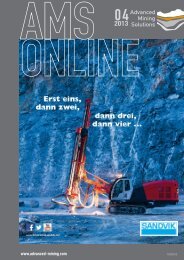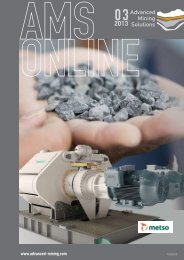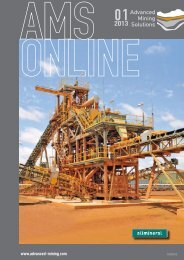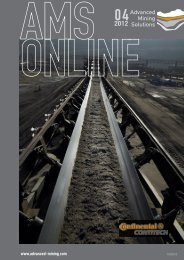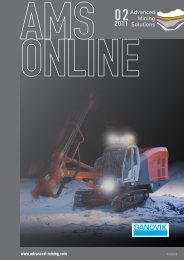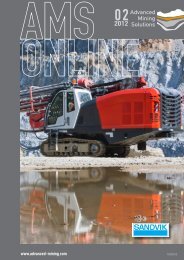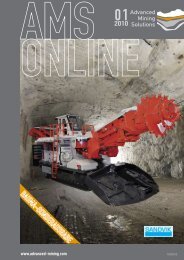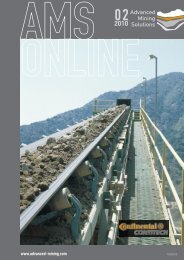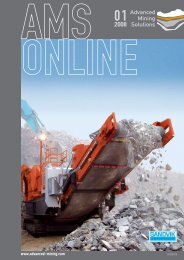A new face drilling rig for narrow tunnels and ... - Advanced Mining
A new face drilling rig for narrow tunnels and ... - Advanced Mining
A new face drilling rig for narrow tunnels and ... - Advanced Mining
You also want an ePaper? Increase the reach of your titles
YUMPU automatically turns print PDFs into web optimized ePapers that Google loves.
Sound proofing by insulation<br />
Apart from the possibilities to take directly measures<br />
at the source of sound, already described in part be<strong>for</strong>e,<br />
there is a further proven medium, the sound insulation.<br />
Here, the sources of sound, like drive units, get completely<br />
covered by means of sound insulation elements. When<br />
planning such sound insulations or claddings, care has<br />
to be taken that the sound insulation factors given by the<br />
manufacturers <strong>for</strong> the sound insulation elements, or in the<br />
sound insulation cladding itself, will not be reached.<br />
The insulation property of a wall with respect to the<br />
sound protection is expressed by the so-called sound<br />
insulation factor R. The sound insulation factor R is the<br />
logarithmic ratio that the sound power that impinges on<br />
a wall bears to the sound power that passes a wall. The<br />
sound insulation factor is dependent on the frequency <strong>and</strong><br />
the sound wave angle, what cannot directly be seen from<br />
the defining equation.<br />
If the sound insulation factor of a sound insulation<br />
element is plotted over the frequency, there will be <strong>for</strong>med<br />
the so-called sound insulation curve. It is a function of<br />
the <strong>rig</strong>idity, the resonant frequency, the mass <strong>and</strong> the<br />
coincident frequency. In the sound insulation curve there<br />
are three different ranges. Within the range of resonant<br />
frequency <strong>and</strong> coincident frequency, there can be clearly<br />
seen invasions of the sound insulation factor. The two<br />
ranges are separated from each other by a linear range to<br />
which the mass law does apply. The mass law expresses<br />
that a doubling of the frequency or a doubling of the basis<br />
weight of the wall improves the sound insulation by 6dB.<br />
The notation with which we are familiar now enables the<br />
mass law to be <strong>for</strong>mulated, as follows:<br />
If the incident sound wave shows the same or a similar<br />
frequency as the natural frequency of the wall, the wall<br />
will be excited to stronger vibrations. In case of the<br />
coincidence, the incident sound wave, or the projection of<br />
the wave, has the same wave length as the bending wave<br />
that is produced in the wall. So, the bending waves in the<br />
wall become excited to a higher degree.<br />
If the sound wave strikes a wall below an angle δ,<br />
Issue 04 | 2010<br />
TRANSFER OF TECHNOLOGY<br />
<strong>and</strong> if the wave length of the incident sound wave λ 0 is<br />
to the bending wave length of the wall λ B as the sine of<br />
the incident angle, it will come to coincidence. The wall<br />
becomes acoustically transparent within this area. That is<br />
the effect called coincidence influx.<br />
When making use of sound insulation claddings, the area<br />
of the resonance influx is dependent on the construction<br />
<strong>and</strong> the area of the coincidence influx on the material.<br />
Fig. 27:<br />
Coincidence effect<br />
Fig. 26:<br />
Sound insulation curve<br />
When planning sound insulation claddings, the thermal<br />
dissipation from the housing into the environment, while<br />
using sound absorbers, has to be taken into account.<br />
Furthermore, there is to be drawn up a thermal balance,<br />
considering the environmental <strong>and</strong> climatic conditions.<br />
www.advanced-mining.com<br />
90



